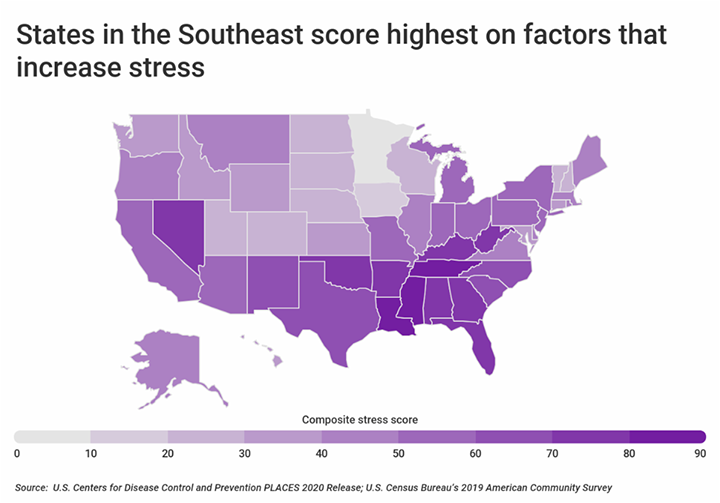It’s no secret that 2020 was an extremely stressful year for almost everyone. Early in the year, COVID-19 began to spread far and wide, bringing life to a halt with stay-at-home orders in the spring. People transitioned to working and schooling virtually, and the shutdowns and accompanying shifts in consumer patterns created economic shocks that disrupted many sectors. Record numbers of Americans began applying for unemployment benefits and struggled to afford basic necessities like food and housing.
On top of that, the U.S. was in the midst of a grueling, bitterly contested election cycle with constant news coverage adding to Americans’ mental burdens. And due to efforts to stop the spread of the coronavirus, many of the comforts people look to for stress relief — an exercise class at the gym, a night out at a restaurant or concert, a religious service at a house of worship, simple quality time with family and friends — have been disrupted, transformed, or simply unavailable for much of the last year.
While it feels like the last year elevated stress to all-time highs, the U.S. is a stressed-out country in general. Worldwide polling from Gallup finds that Americans express feelings of stress, worry, and anger more frequently than populations in almost every other country. This matters because chronic stress disturbs the immune, digestive, cardiovascular, sleep, and reproductive systems and increases susceptibility to serious conditions like heart disease and diabetes. Americans’ high levels of stress could be one of the reasons why the U.S. trails many other developed nations with regards to health and life expectancy.
One of the issues that makes stress a particularly challenging health issue is that many of the factors contributing to stress are self-reinforcing. For instance, a low income may make it difficult for a family to find affordable, quality housing; substandard housing may increase the family’s risk for health conditions like asthma or poor nutrition; and the costs of treating those health conditions may put even more strain on the family’s finances. The combined health and economic effects create even more worry, uncertainty, and stress for the family.
Because of that reinforcing cycle, one factor highly correlated to stress levels is economic insecurity. Households that struggle to secure basic necessities like steady income, safe housing, and healthy food are more likely to experience high levels of stress and the accompanying effects. This means that many of the areas experiencing the highest levels of stress are also likely to be the areas experiencing high levels of poverty and economic insecurity.

Because of that reinforcing cycle, one Indeed, the map of the most-stressed states shows high levels of vulnerability in the Southeast, which is also where most of the highest-poverty states in the U.S. are located. Mississippi is both the poorest and most stress-prone state, while neighboring Louisiana is second for both categories. At the local level, many of the same patterns hold — many of the most vulnerable cities tend to be located in the high-poverty Southeast or in other economically distressed areas like the Rust Belt.
To identify these stressful locations, researchers at RetailMeNot created a composite measure based on CDC and Census data about factors that contribute to stress. These include measures for self-reported mental and physical health, economic indicators like poverty and economic inequality, and health behaviors like good sleep and physical activity.
The analysis generated a composite score of 81.13 for Tennessee. Out of all U.S. states, Tennessee is the 3rd most stressed-out. Here is a summary of the data for Tennessee:
• Composite stress score: 81.13
• Population reporting poor mental health: 16.6%
• Population reporting poor physical health: 14.8%
• Population without health insurance: 10.1%
• Median housing costs as a percentage of income: 18.8%
• Poverty rate: 13.9%
• Gini index of economic inequality: 0.4749
• Population sleeping less than 7 hours/night: 41.3%
• Population reporting no leisure time physical activity: 30.1%
For reference, here are the statistics for the entire United States:
• Composite stress score: N/A
• Population reporting poor mental health: 12.9%
• Population reporting poor physical health: 11.8%
• Population without health insurance: 9.2%
• Median housing costs as a percentage of income: 20.3%
• Poverty rate: 12.3%
• Gini index of economic inequality: 0.4811
• Population sleeping less than 7 hours/night: 36.2%
• Population reporting no leisure time physical activity: 23.6%
Source: RetailMeNot

